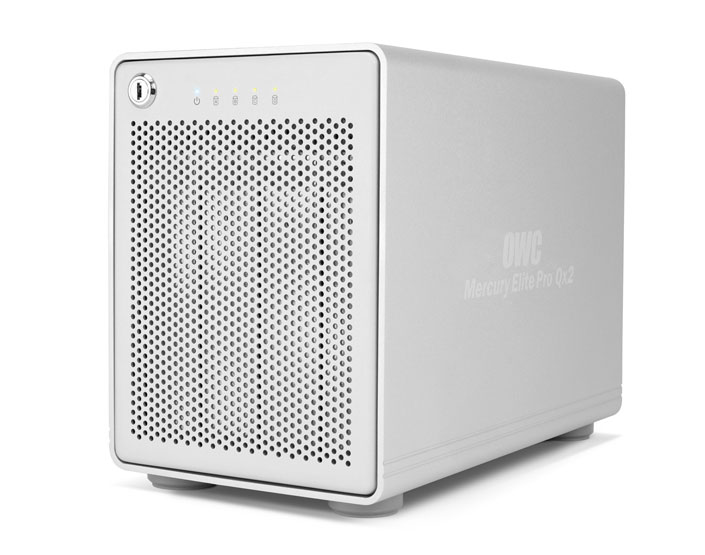OWC Updates Mercury Elite Pro Qx2 Line
Following the release of its 10 TB Mercury Elite Pro Dual model, Other World Computing has also updated its Mercury Elite Pro Qx2 RAID storage line with a 20 TB capacity, making it the largest and most expensive solution in this series. This is a four bay form factor, enabling up to four 5 TB drives in one enclosure.
"We've listened to customer demands for increased capacities and now the extremely robust Elite Pro Qx2 is larger to better handle 4K video files," said Larry O'Connor, founder and CEO, Other World Computing. "Its unique mix of multiple drive capacities, multiple high-speed interfaces, and multiple drive modes makes it the premier choice for power users."
According to a list of features, connectivity options include one USB 3.0 port, two FireWire 800 ports, and an eSATA port, providing compatibility with different operating systems and hardware setups right out of the box. The Elite Pro Qx2 is also pre-configured in RAID-5 mode (Stripe with Parity), but users can set the device to Span, 0 (Stripe), 1 (Mirror), 10 (1+0), and JBOD/Independent modes.
The Elite Pro Qx2 line also provides front panel LEDs for quickly checking on its status, and a removable key lock to keep those hard drives safe and secure. The enclosure is made out of rugged brushed aluminum, and features a fan in the back and a perforated faceplate that allows the heat to escape. All models measure 5.31(W) x 6.96(H) x 9.65(D) inches and weigh 8.6 pounds. The maximum data transfer rate is 300 MB/s via USB 3.0 or eSATA.
Included in this storage solution is a bundle of software worth $200 including Intech Hard Disk, SpeedTools Utilities, ProSoft Engineering Data Backup, NovaStor NovaBACKUP and over 1.5 GB of freeware, shareware, and public domain software. Here's the list of models and their pricing:
- 4.0 TB 7200 RPM (1 TB x 4) = $ 549.99
- 8.0 TB 7200 RPM (2 TB x 4) = $ 699.99
- 12.0 TB 7200 RPM (3 TB x 4) = $ 849.99
- 16.0 TB 7200 RPM (4 TB x 4) = $ 1,229.99
- 20.0 TB 7200 RPM (5 TB x 4) = $ 1,579.99
Also available is a kit with no Drives:
- 0 GB Kit add/mix/match up to four (4) SATA Drives = $ 279.00
Get Tom's Hardware's best news and in-depth reviews, straight to your inbox.

Kevin Parrish has over a decade of experience as a writer, editor, and product tester. His work focused on computer hardware, networking equipment, smartphones, tablets, gaming consoles, and other internet-connected devices. His work has appeared in Tom's Hardware, Tom's Guide, Maximum PC, Digital Trends, Android Authority, How-To Geek, Lifewire, and others.
